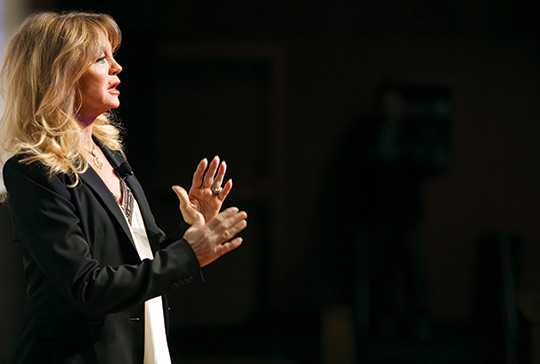Goldie Hawn at Academic Festival: A Call for Society to "Mind Up"
“Not all of us are going to be scientists who change the world—so we need to create a group of people who can behave in a civil fashion, who can share and care and have empathy, and reach down inside themselves and find optimism. So why aren’t we teaching kids about their brains?”
Speaking at TC’s seventh annual Academic Festival on April 11th, the academy award-winning actress and children’s advocate Goldie Hawn delivered an impassioned plea for incorporating mindfulness training and education into classroom culture—both for children and educators themselves. [Check out video of other sessions at Academic Festival, too.]
The Hawn Foundation, which provides social and emotional learning programs to reduce children’s stress and aggressive behavior and improve their focus and academic performance, has made its “MindUPTM” program available to 700,000 children in countries around the world.
Hawn said she began to get interested in mindfulness in 2001 after the 9/11 attacks. “I was very concerned about the wellbeing of our children. How were we preparing them emotionally and cognitively? How were we giving them the spirit of resilience? And how could we mitigate the frenzy their parents were feeling?” Her concerns have only increased in an era when “we put more and more books on kids’ backs” and pressure them to perform on batteries of standardized tests.
“We don’t have to pop pills in children,” Hawn said. “Instead we need to give them tools to move through depression and fear.” A “brain break” three or four times a day is one such tool. "And if we’re not doing it in the home, let’s do it in schools so they can use it for the rest of their lives. It’s not magic, woo-woo—focused attention is about the brain. It’s connected to neurobiology, and it’s not just, If you sit and go 'Ohm', you’ll feel better. There’s a cognitive reason. It strengthens lobes in the brain.”
There’s just as much need for “teacher care,” Hawn added. “It’s important for teachers to have tools for when they’re saying, ‘There’s too much for me to handle, what’s in it for me?’ So when everyone in your class breathes and sits down, it’s a way to buy time for you, too.”
(Published 4/21/2015)
Published Tuesday, Apr. 21, 2015
